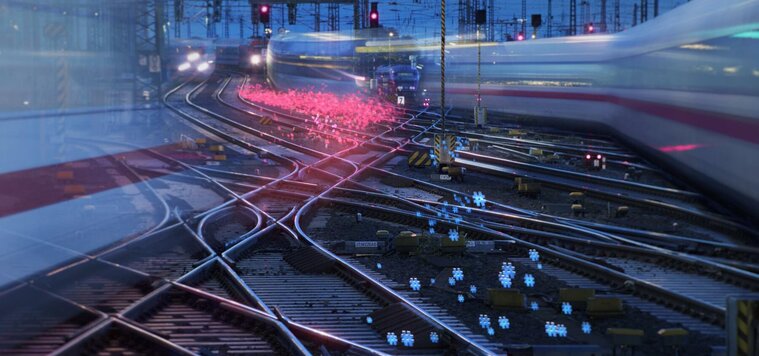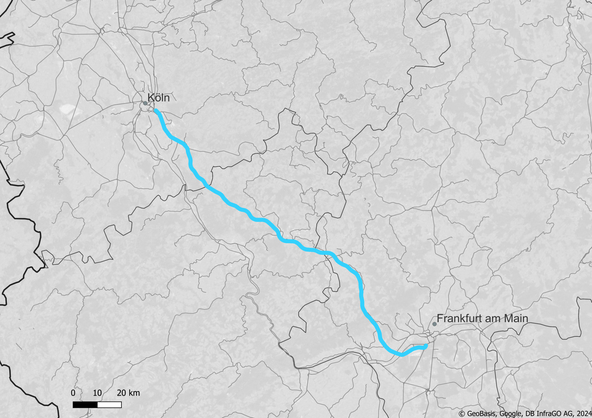
Cologne-Rhine/Main high-speed line
The Cologne-Rhine/Main high-speed line is one of the three projects in the starter package. 20 years after the construction of the approximately 180 km long route, an upgrade is now due: the digitalisation of the LST. This involves the introduction of ETCS and the modernisation of the interlocking.
Project duration
Route data
| Line from | Cologne |
|---|---|
| Line to | Frankfurt am Main |
| Kilometers of line to be equipped | 173 km ETCS, 300 km DSTW |
| Route number(s) | 2690 (ETCS), 2690 and line sections UZ Troisdorf I – 2691, 2324, 2651 (digital signalling technology) |
Planned actions
| ETCS | Level 2 without signals |
|---|---|
| Interlockings | 2 DSTW |
| Scope of equipment |
|
| Planned speed | 300 km/h |
Contact
Disclaimer
The dates shown are legally non-binding forecasts based on the current status. The forecasts are in no way intended to establish any kind of legal claim whatsoever that completion will take place by the specified date and that use will be possible. For these reasons, the information should also not be used to make or prepare business decisions, for example, but not conclusively, with regard to the vehicle equipment or the compatibility between the vehicles and the infrastructure. If you have any questions, particularly regarding technical network access or obtaining binding information, please contact your customer advisor.
Most of the infrastructure projects are still in the planning phase, which means that the information provided on these pages reflects the current planning status and is updated regularly.

Alongside the Fast-Track Programme, the starter package marks the start of the rollout of Digitale Schiene Deutschland (DSD). With a target horizon of 2030, the routes will be equipped with the European Train Control System (ETCS) and modern interlockings in three projects and thus comprehensively digitised. In this way, the technologies, some of which date back to the 19th century, will be replaced. The knowledge gained from the starter package will be incorporated into the rollout of DSD for the entire German rail network.
The Cologne-Rhine/Main high-speed line (2690) is one of the three projects in the starter package. With a route length of around 180 km and speeds of 300 km/h, it connects the two major cities Cologne and Frankfurt am Main. The route has 27 tunnels with a total length of around 40 km and 18 bridges with a total length of around 6 km. Twenty years after its construction, an upgrade is now due: the digitalisation of the control and safety technology (LST).
The line will be equipped with ETCS level 2 without signals (ETCS L2oS). This includes the replacement of the three controlling Electronic Interlocking sub-centers (ESTW-UZ) in Troisdorf I, Montabaur and Frankfurt Airport long-distance train station with modern interlockings. The project also includes upgrading the telecommunications systems as well as the construction of the Troisdorf and Frankfurt II operational centers (BSO) and the Troisdorf and Limburg technical systems centers (TSO), taking into account the Operations Control Strategy (BSS).
The total length of track to be equipped with ETCS is around 173 km. Taking ETCS entry and exit points into account, approximately 200 kilometers of track are planned for implementation with ETCS. The installation of modern interlockings will lead to a further increase in the number of line kilometers to be equipped with ETCS, as it makes technical sense to equip entire sections with ETCS. In the Cologne network, sections of line that are not part of the Cologne-Rhine/Main high-speed line will therefore also be equipped with modern interlockings and will be equipped with ETCS as part of another project (Corridor Rhine-Alpine). In total, around 300 kilometers of track are to be equipped with modern interlockings and ETCS.
In future, the line will be controlled from two operational centers (BSO). The modern interlocking will be located at two technical systems centers (TSO). So the Cologne network will be controlled from the Troisdorf BSO and the Frankfurt network from the Frankfurt BSO. The technology will be located in Troisdorf and Limburg TSO. In this way, 1,237 control units, including 230 points, will be controlled from these locations.
The planning is currently (as at 05/2025) in preliminary design (HOAI phase 3). The LST-planning includes a block optimisation and the installation of track switching operation at all previously missing points within the route. The project planning is generally BIM-capable, with digital planning also being used in the LST area. This means that the entire planning is mapped in virtual up to 5D-models. Start of construction work is scheduled to mid-2027. Commissioning is scheduled for December 2030.
The high-speed line will ultimately be one of the first routes to be fully equipped with ETCS and modern interlockings. Deutsche Bahn will gather experience for the further rollout of DSD with its partners, in particular politicians and industry: Regulations will be adapted, processes accelerated and operational trials and commissioning procedures tested. Passengers will benefit from greater reliability.
Bauende Bahn
This is a Deutsche Bahn project. We are building. So that people can build on us again. More information about the Bauende Bahn can be found here (in German only).
The starter package aims to comprehensively digitalise rail lines through ETCS and modern interlockings. This will replace a lot of old systems, some dating back to the 19th century. The lessons learned of the starter package will be incorporated into the rollout of Digitale Schiene Deutschland to the entire German rail network.
Starter package projects
The following two projects are part of the starter package in addition to the Cologne-Rhine/Main high-speed line (SFS KRM):
- Corridor Scandinavian-Mediterranean (ScanMed) with adjoining DB Netz districts
- Stuttgart Digital Node (DKS)


